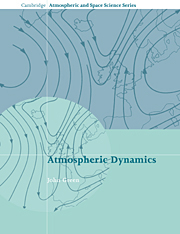Book contents
- Frontmatter
- Contents
- Introduction
- Chapter 1 Description of atmospheric motion systems
- Chapter 2 Notation
- Chapter 3 Fundamental equations
- Chapter 4 Nearly horizontal atmosphere
- Chapter 5 Gravity waves
- Chapter 6 Shearing instability
- Chapter 7 Vertical convection
- Chapter 8 Mesoscale motion
- Chapter 9 Motion of large scale
- Chapter 10 The forecast problem
- Chapter 11 Motion in a barotropic atmosphere
- Chapter 12 Modelling
- Chapter 13 Models
- Chapter 14 Transport and mixing
- Chapter 15 General circulation
- Appendix
- Index
Chapter 1 - Description of atmospheric motion systems
Published online by Cambridge University Press: 17 September 2009
- Frontmatter
- Contents
- Introduction
- Chapter 1 Description of atmospheric motion systems
- Chapter 2 Notation
- Chapter 3 Fundamental equations
- Chapter 4 Nearly horizontal atmosphere
- Chapter 5 Gravity waves
- Chapter 6 Shearing instability
- Chapter 7 Vertical convection
- Chapter 8 Mesoscale motion
- Chapter 9 Motion of large scale
- Chapter 10 The forecast problem
- Chapter 11 Motion in a barotropic atmosphere
- Chapter 12 Modelling
- Chapter 13 Models
- Chapter 14 Transport and mixing
- Chapter 15 General circulation
- Appendix
- Index
Summary
And God created great whales, and every living thing that moveth, which the waters brought forth abundantly after their kind, and every winged fowl after his kind: and God saw that it was good.
Introduction
We usually notice phenomena; events isolated in space, but most of this book will rely on a wave formalism. This chapter explores some of the relations between the two forms of description. We are going to describe a great variety of motion systems, with broad classes, but with each member of each class different. Moreover, the definition of the class depends, to some extent, on the reason we are trying to classify the phenomenon. A cumulus cloud is fairly well defined, in the sense that two independent observers will (usually) agree that a specific cloud should be put in that broad category. There will be some debate as to whether this specimen is young or old, becoming congested, and such subtleties are important as indicators of the future development of the convection. The particular one we see now is an individual, and studied for a specific purpose; it might make a gust that will disturb my boat, cover up the sun, precipitate soon, carry aphids/momentum/water vapour, into the higher levels of the troposphere; a whole host of things that will affect the way I look at it.
- Type
- Chapter
- Information
- Atmospheric Dynamics , pp. 3 - 17Publisher: Cambridge University PressPrint publication year: 1999



